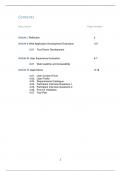Essay
Advanced Internet Development B: Reflection and Evaluations
- Course
- Institution
This section of the report is reflecting on the guest lecture presented by Jonathan Healey for Net Construct. The lecture clarified the importance of making an impact with a website which involved technical and marketing aspects merging together. The three main points to ensuring a website becomes ...
[Show more]



